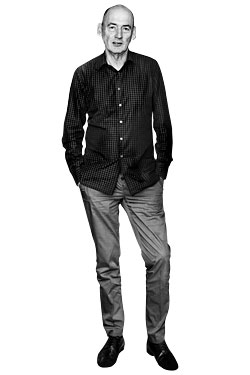
Rem Koolhaas, the globe-trotting architectural philosopher and provocateur, is impatient for his daily swim. We meet in front of NYU’s Coles Sports Center, a place he has chosen mostly for the pool but also because he enjoys the way two architectural universes face off across Mercer Street. To the west, I. M. Pei’s concrete Silver Towers rear up, massive and austere. To the east, everything is Village quaint.
“I like the strange insertions of modern architecture,” he says. “And I like that it’s not quite Soho.” Conversing with Koolhaas is like interrogating an oracle. He utters wordy, sweeping aphorisms in a deadpan monotone, mixing astuteness, paradox, and ridiculous overstatement. “Architecture now, in spite of its visual richness, is actually simplistic and sedate,” he tells me. I let that roll around my mind, which starts frothing with counterexamples, but before I can articulate a challenge, he’s moved on.
“Most of us work almost exclusively for the private sector,” he laments, referring as he usually does to himself and a few gold-plated peers. But doesn’t his most flamboyant and controversial building, the twisted-pretzel headquarters of China’s government-run TV broadcaster, contradict that generalization? “Yes, in China, even the private sector is actually the public sector,” he says. “That’s one main reason to work there: You’re dealing with something more than private ambition.”
Sitting between us on our bench is the bricklike Project Japan: Metabolism Talks, a book of interviews that Koolhaas and the curator Hans Ulrich Obrist conducted with the Japanese architects who formed the Metabolism movement in the sixties. It’s the kind of visually stuffed, exhaustively researched tome Koolhaas has specialized in since his 1978 opus Delirious New York, but this book feels more wistful, less optimistic. It’s hard to miss its hint of envy for the Metabolists, a collective of architects with a state-approved mission to modernize their country and a clear sense of how to forge a contemporary style out of national tradition.
“I miss that cohesiveness,” he says. “Now there is zero communication among architects. We’re all doing our own thing; none of it is even remotely connected to the traditions of our own countries. There’s nothing Dutch about my architecture. We are constantly competing against each other, and winning a competition can make the difference between five years of work and … nothing. It’s difficult to remain lucid and friendly.”
Koolhaas insists he’s not complaining about the frivolousness of contemporary design, or the loss of shared artistic beliefs, or the prevalence of plutocrat clients, and certainly not about the bizarre demands of being lionized. “The word celebrity and the word architect are basically incompatible. I know it’s come to pass that some of us have become famous, but it’s a temporary condition, a strange pact: We get a lot of attention, but we’re taken less seriously. Journalists seem mostly interested in what brand of shoes I wear.” (Here, I involuntarily look at his feet. Nice shoes, I think, but I can’t bring myself to ask the question.)
Koolhaas is both a creator and an iconoclast, an architect who for a couple of decades has managed to be both radical and furiously in demand. The buildings he designs with his less attention-getting colleagues at Rotterdam’s Office for Metropolitan Architecture can be brilliant and mystifying at the same time: The Casa da Música in Porto, Portugal, sits in the middle of a square, like a melting iceberg, advertising itself more than the concerts inside. “We’ve been toning down the volume,” he says. “We’re doing buildings that are almost discreet.” He mentions the relatively demure tower for Rothschild Bank in London, which is nearing completion and looks as if the topmost segment has been removed and replaced incorrectly.
He also has no problem with the fact that he’s never had a building actually go up in New York. “Architecture is not really the issue, here,” he says. “The whole system is so strong and the geography so unique that any one building doesn’t matter much.” Is it possible, I suggest, that New York simply doesn’t really need Rem Koolhaas? For the first time in nearly three-quarters of an hour, his lips laboriously arrange themselves into a smile. “It’s a surprising conclusion, and I wouldn’t want to confirm it,” he answers. “But I can’t deny it either.
“Okay, I have to swim now,” he concludes, and lopes lovingly into a building so undistinguished that NYU plans to tear it down.
Have good intel? Send tips to intel@nymag.com.
